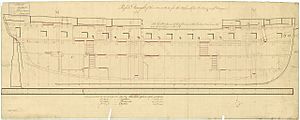HMS Cossack (1806) facts for kids

Cossack
|
|
Quick facts for kids History |
|
|---|---|
| Name | HMS Cossack |
| Ordered | 30 January 1805 |
| Builder | Simon Temple, South Shields |
| Laid down | July 1805 |
| Launched | 24 December 1806 |
| Completed | 2 July 1807 at Chatham Dockyard |
| Commissioned | early 1807 |
| Fate | Broken up in June 1816 |
| General characteristics | |
| Class and type | 22-gun Banterer-class post ship |
| Tons burthen | 54560⁄94 (bm) |
| Length |
|
| Beam | 32 ft 3+1⁄2 in (9.8 m) |
| Depth of hold | 10 ft 6 in (3.20 m) |
| Sail plan | Full-rigged ship |
| Complement | 155 (later 175) |
| Armament |
|
HMS Cossack was a British warship from the time of the Napoleonic Wars. She was a "post ship," which was a type of sailing warship with 20 to 24 guns. Cossack was built in South Shields, England, and launched in 1806. She served the Royal Navy for about ten years, taking part in some important events but not seeing a lot of direct fighting.
Contents
The Ship's Design and Crew
Cossack was designed to carry 22 long 9-pounder guns on her main deck. However, she also had eight 24-pounder carronades and two long 6-pounder guns on her quarterdeck and forecastle. Carronades were shorter, lighter cannons that fired heavy cannonballs over shorter distances.
When Captain George Digby took command in early 1807, the British Admiralty (the group in charge of the navy) changed her weapons. They swapped her 9-pounders for more powerful 32-pounder carronades. They also added two brass howitzers, which were another type of short cannon. Her crew also grew from 155 to 175 sailors and officers.
Early Missions and Battles
Cossack was part of the Battle of Copenhagen in 1807. This was a major event where the British Navy captured the Danish fleet. Cossack shared in the prize money from this victory. She also shared in the money from capturing a ship called Minerva in August 1807.
Around this time, while Cossack was sailing in the Little Belt (a strait between Danish islands), her smaller boats captured a brig (a type of two-masted ship). Sadly, during this action, the French managed to capture one of Cossack's boats. Two British sailors were killed, three were wounded, and some others were captured.
Helping Spanish Loyalists
In June 1808, Cossack and another ship, Comet, sailed to St Andero in Spain. Their mission was to help Spanish people who were loyal to their king and bring any British citizens to safety. Spain was fighting against French forces at the time.
On June 21, sailors and Royal Marines from Cossack and Comet went ashore. They spiked the guns of two forts near St Andero, Fort St Salvador de Ano and Fort Sedra. "Spiking" a gun meant making it unusable so the French couldn't use it. They also blew up two magazines, which were places where gunpowder was stored. During this dangerous mission, Captain Daly of Comet and Lieutenant Read of the Marines were injured when one of the magazines exploded.
Capturing Enemy Ships
Cossack was also involved in capturing enemy ships. On June 29, 1808, while off the coast of France, Cossack along with Template:French frigate Embuscade (1789), Comet, and Unicorn captured a French brig named Pierre Caesar. The British Navy later took Pierre Caesar into their own service as Tigress.
Later, on August 5, Cossack captured a French schooner (a type of sailing vessel) called Mouche in the English Channel. Mouche was carrying important messages from Bayonne, France, to Havana, Cuba.
In March 1809, Cossack captured another valuable French ship called Celestene. This ship was coming from the Isles of France (now Mauritius) with a valuable cargo. During the chase, Celestene threw 16 of her guns overboard to try and escape, but Cossack still managed to capture her.
Later Years and Commanders
Over her years of service, Cossack had several different captains:
- In November 1810, Captain Thomas Garth took command.
- In April 1811, Captain Thomas Searle became her captain.
- In February 1812, Captain William King took over and sailed Cossack to Portugal in June.
- In February 1813, Captain Francis Stanfell became her commander. Under him, Cossack escorted a group of merchant ships (a convoy) to Jamaica. She then served in North America, where she was damaged in a storm.
- In March 1814, Captain Edward Silby replaced Stanfell.
- Four months later, Captain James Erskine Wemyss took command.
- In August 1814, Captain the Honourable Robert Rodney became her captain.
- On March 19, 1815, Cossack helped an American schooner named Thistle and earned a share of the money for saving the ship.
- Cossack's last commander was Captain Lord Algernon Percy, who took command in August 1815. Under Percy, Cossack continued to serve on the North American station.
Fate of HMS Cossack
After about ten years of service, HMS Cossack was taken apart, or "broken up," in Portsmouth in June 1816.

